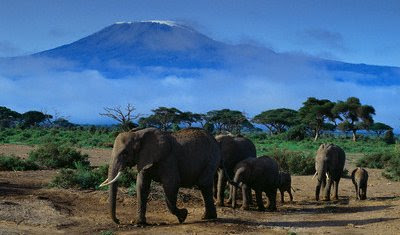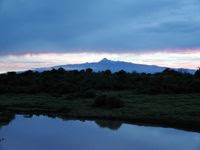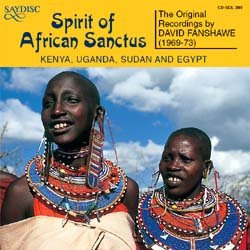
Bantu culture most likely reached Kenya from the west, and possibly the south, around AD 200, having passed through what is now Congo.

[Elephants in Amboseli Park, Kenya, looking south to Mt. Kilamanjaro, Tanzania]
Although uncertain, ethnologists believe the Kikuyu came to Kenya from West Africa together with the other Bantu groups. On reaching present Tanzania, they moved east past Mount Kilimanjaro and into Kenya,

finally settling around Mount Kenya. They were originally hunter-gatherers but unlike the Nilotic tribes who were pastoralists, they began farming the very fertile volcanic land around Mt. Kenya and the Kenyan highlands.
As cultivators, the Bantu sought out abundantly watered areas, often in the highlands, and were the first to begin large-scale forest clearance for cultivation, with the result that even today many Bantu areas suffer enormous losses of topsoil each year through erosion.
Although the new-comers were frequently displaced, and sometimes fused with previous Bantu immigrants, Cushitic peoples (from whom some pastoral practices were adopted) or the hunters and gatherers they came across, the essence of Bantu identity remained the same, namely the reliance on agriculture, and hence a relatively settled way of life. Other pan-Bantu cultural elements which have survived, and not just in Kenya, are cosmological beliefs, such as the belief in a single creator God, and the belief in the survival of ancestors as spirits or intermediaries between the living and God.
Although it's obvious that the Bantu must have moved north to populate the areas they cover today in Kenya, the oral legends of the central highlands Bantu invariably point to the north - usually the Nyambene Hills which lie north of Mount Kenya - as their place of origin (ie. some five hundred years ago).
From there, say their oral histories, the ancestors of the present-day Kikuyu, Meru, Embu, Chuka and Kamba, and possibly others as well, migrated south into the foothills of Mount Kenya itself, where they eventually dispersed to their present locations.
This would indicate that once in Kenya, the Bantu headed much further north than their present territories, and were pushed back by either the Nilotes or Cushites. This theory is backed-up by other oral histories which state that the central highlands Bantu came not from the north or west, but from the Indian Ocean coast to the east.
Being a settled culture, the Bantu were inherently at risk of attack from the mobile nomadic Nilotic and Cushitic cattle and camel herders such as the Maasai, Borana (Oromo) and Somali, and as a result many Bantu societies became characterised by their defensive nature. None of the Kenyan Bantu groups lived on open land (ideal territory for the herders), having preferred, for both economic (agricultural) and defensive reasons, to occupy the less accessible highland regions.
Settlements were built with the greatest attention to defence, and were also well concealed: Europeans found they could be walking only yards from a settlement without knowing of its existence.
Some tribes, like the Kikuyu, became experts at adapting and adopting to new realities, and rarely resorted to conflict. Others, like the Chuka, developed an array of inventive defensive measures, ranging from ingenious traps to tree houses and fortifications. Almost all the Bantu groups also adopted a rigid system of age-sets (an idea possibly borrowed from the Nilotic or Cushitic peoples they came across), in which all people of similar age were initiated into an age-set, which together progressed through clearly defined phases of social responsibilities, functions and status, from initiation, through warriorhood, marriage and elderhood to death.
The system ensured the cohesion of society, as well as enabling the development of the warrior system, by which all the young men of a given society would, shortly after initiation to adulthood and their age-set, take up the role of defending the entire society.

A work song is typically a rhythmic a cappella song sung by people working on a physical and often repetitive task. The work song is probably intended to reduce feelings of boredom.
Kenya - Jembelangu (My Spade)
[7300 Tahiti / 7200 Kenya / 7100 Uganda]
